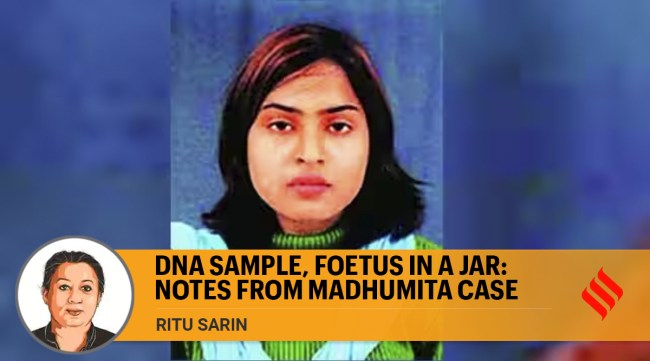Opinion DNA sample, foetus in a jar: Notes from Madhumita case
In hushed tones, a neighbour confirmed what I had already heard in Delhi — Madhumita was pregnant at the time of her murder and that Amarmani Tripathi, then Minister of State for Stamps and Stationary, was the prime suspect.
 DNA fingerprinting in the Madhumita Shukla case became the cause célèbre for forensics and crime detection way back in 2003.
DNA fingerprinting in the Madhumita Shukla case became the cause célèbre for forensics and crime detection way back in 2003.
In May 2003, I was asked to cover the murder of Madhumita Shukla. A budding poet, Madhumita was shot dead at her house in Lucknow on May 9 that year. Some bizarre details of the crime remain fresh in my mind two decades later.
I recall landing in Lucknow in the scorching heat. The car that arrived at the airport did not have air conditioning, so I covered my face with a dupatta and went directly to Lakhimpur Kheri. The victim’s family home was located about 130 km from the Uttar Pradesh capital.
The house was full of mourning relatives. Madhumita’s mother, Shanti, and her sister, Nidhi, were inconsolable. There was a gaggle of local reporters and heavy police deployment as everyone waited for the ambulance carrying Madhumita’s body to arrive.
When the ambulance was quite close, a mere 30 km away, someone in the crowd exclaimed with consternation, “Wapas chale gaye (they have gone back).”
 The IE edition dated May 14, 2003
The IE edition dated May 14, 2003
In hushed tones, a neighbour confirmed what I had already heard in Delhi — Madhumita was pregnant at the time of her murder and that Amarmani Tripathi, then Minister of State for Stamps and Stationary, was the prime suspect. Within minutes, an even more sensational development came to light — that the Uttar Pradesh police’s crime team had “forgotten” to take a DNA sample of Madhumita’s foetus, which necessitated a second post-mortem in Lucknow. Very early the next morning, I reached Mahanagar Police Station in Lucknow. At the station, I learnt that Madhumita’s foetus was lying in the malkhana.
“Dus talon ke andar rakha hai usko (we have secured it with 10 locks),” a constable said authoritatively. Desperate to get close to the “story”, I pleaded with him, “Can I please, please see the exhibit — just for a minute?”
The locks of the malkhana were opened for me. Sitting there on a wooden shelf, along with bundles of old files tied with red cords, was a large plastic jar full of formalin and the seven-month-old foetus. As it turned out later, DNA fingerprinting in the Madhumita Shukla case became the cause célèbre for forensics and crime detection way back in 2003.
Back in Delhi, I closely monitored the murder probe, which had by then been handed over to the Central Bureau of Investigation (CBI).
The DNA sample obtained from Madhumita’s foetus — via a court order; a special wooden box was obtained to take it to a forensic laboratory in Hyderabad — was to be matched with that of Amarmani. In a first for the agency, in mid-August 2003, the CBI called the ex-UP minister to New Delhi to give a blood sample.
That was not all. The clincher was the CBI managing to isolate DNA samples from washed underwear found in a drawer in Madhumita’s house in Paper Mill Colony in Lucknow, where she was gunned down. I managed to get a copy of the six-page final report sent by the Hyderabad forensic laboratory to the CBI. The report, that reached the CBI on September 19, 2003, detailed how two of 11 underwear contained DNA samples of the politician’s semen, which conclusively established that DNA from Amarmani’s semen matched that of the foetus and his blood sample.
The report read, “The foetal DNA has matched with the DNA profile from the source of the exhibits (underwear) and (Amarmani’s) blood sample.”
Besides DNA fingerprinting, the CBI had sufficient corroborative evidence in the case — the confessional statements of the shooter hired by Amarmani, her house help, her personal diary and so on. Though he was arrested in September 2003, it took four years — October 24, 2007 — for the courts to hand out the conviction of life imprisonment to Amarmani and his wife, Madhumani.
Last month, nearly two decades after the shooting, the dubious duo were granted remission by court.






